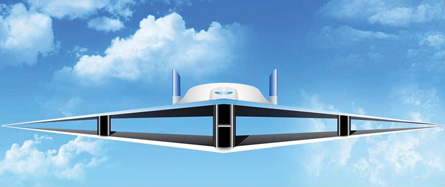Intuition might suggest that a biplane is not very fast, but intuition is often wrong when an aircraft goes beyond the "sound barrier". That's the situation for the quiet supersonic biplane, a design proposed by German engineer Adolf Busemann in the 1950s.
Researchers at the Massachusetts Institute of Technology (MIT) and Stanford University have resurrected Busemann's biplane using the latest advances in aerodynamic modelling and simulation, to see if the idea might have 21st-century appeal.
Busemann proposed the idea as a way of dealing with the primary concern of supersonic aircraft for domestic use - the pressure wave that trails behind the supersonic aircraft, creating the annoying sonic boom. In the US and Europe, civil aircraft are prohibited from supersonic overland flight due to the issue, a reality that has aircraft developers investigating a variety of technologies to hush the boom.
 |
|---|
© Christine Daniloff/MIT |
The German engineer proposed two triangular cross-section wings placed one on top of the other, biplane-style, with the apex of each triangle facing the other. His calculations showed that when flying at supersonic speeds, the design as a whole cancelled the shock waves produced by each wing individually.
MIT and Stanford engineers are investigating a flaw with the original concept, however: high drag associated with the constrained airflow between the wings at subsonic and transonic speeds. "While the design could work beautifully at supersonic speeds, it can't overcome the drag to reach those speeds," says MIT researcher Qiqi Wang, an assistant professor of aeronautics and astronautics.
Wang and his associates modelled the Busemann biplane and performed a series of simulations (700 wing configurations at 12 different design speeds) to determine an optimal wing shape that minimises drag. The simulations also revealed a wing design the engineers say could halve supersonic cruise drag compared to an aircraft such as Concorde.
The next step for the team is to design a more comprehensive 3D model.
"Now people are having more ideas on how to improve [Busemann's] design," says Wang. "This may lead to a dramatic improvement, and there may be a boom in the field in the coming years."
Source: Flight International
















